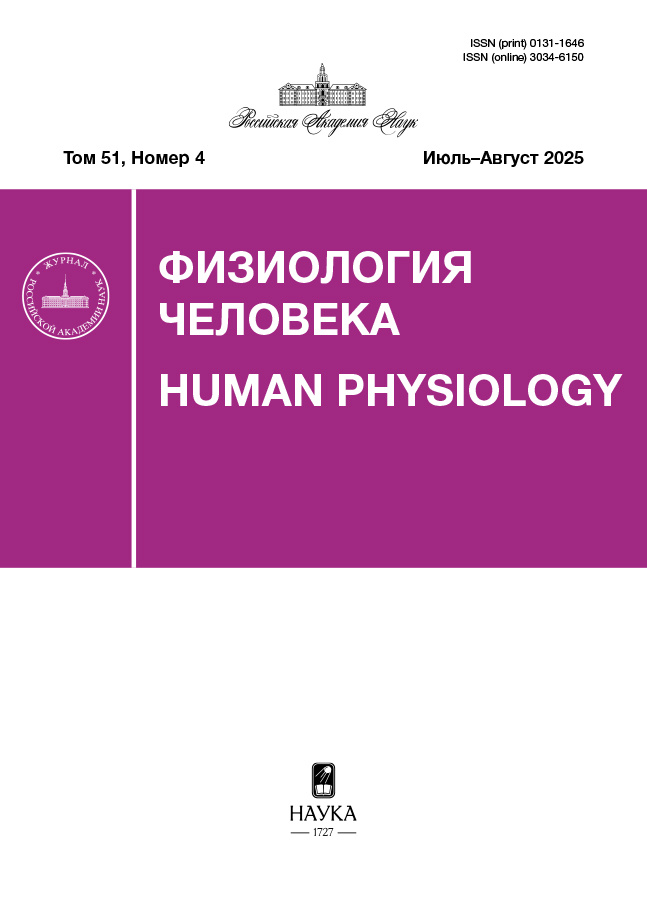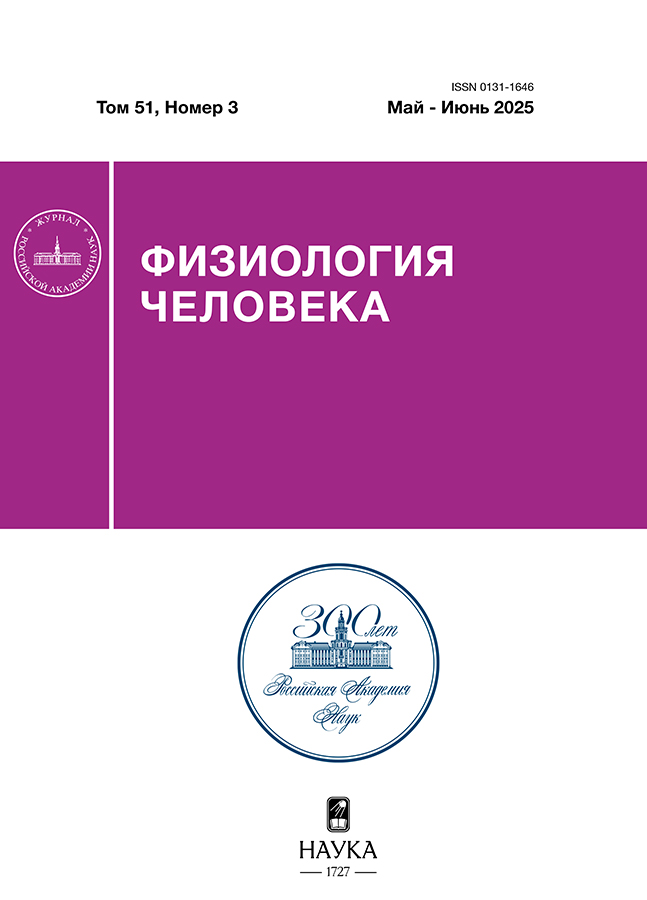Comparison of changes in systemic and cerebral hemodynamics in two variants of the active standing test
- Authors: Zhedyaev R.Y.1, Borovik A.S.1, Vinogradova O.L.1, Tarasova O.S.1,2
-
Affiliations:
- Institute of Biomedical Problems, RAS
- Moscow State University
- Issue: Vol 51, No 3 (2025)
- Pages: 55-62
- Section: Articles
- URL: https://rjmseer.com/0131-1646/article/view/684025
- DOI: https://doi.org/10.31857/S0131164625030063
- EDN: https://elibrary.ru/TQNKHP
- ID: 684025
Cite item
Abstract
Justification of methods for diagnosing disorders of systemic and cerebral hemodynamics in humans is an important task of fundamental medicine. The aim of this study was to compare changes in systemic hemodynamics and cerebral circulation in two modifications of the orthostatic test: during active transition to a standing position from a supine position or from a sitting position. In a group of 11 young volunteers of both sexes, blood pressure (BP), heart rate (HR) and stroke volume (SV) were continuously recorded, and changes in the concentration of oxyhemoglobin (OHb) and total hemoglobin (CHb) in the frontal cortex were assessed using infrared spectroscopy. In none of the tests, significant changes in mean BP occurred during verticalization, whereas changes in HR, SV, spectral power and phase synchronization of mean BP and HR oscillations in the low-frequency range (0.06–0.13 Hz) were observed. For most parameters, these changes were more pronounced in the “supine-standing” test than in the “sitting-standing” test. Along with that, an increase in the spectral power of low-frequency oscillations of CHb and OHb in small cerebral vessels, as well as the degree of synchronization of low-frequency oscillations of OHb and mean BP, which can reflect the processes of cerebral circulation control, were observed only in the “supine-standing” test. Thus, both variants of the active orthostatic test provide an assessment of systemic hemodynamics, whereas the “supine-standing” test is more appropriate for assessing cerebral circulation.
Full Text
About the authors
R. Yu. Zhedyaev
Institute of Biomedical Problems, RAS
Email: tarasovaos@my.msu.ru
Russian Federation, Moscow
A. S. Borovik
Institute of Biomedical Problems, RAS
Email: tarasovaos@my.msu.ru
Russian Federation, Moscow
O. L. Vinogradova
Institute of Biomedical Problems, RAS
Email: tarasovaos@my.msu.ru
Russian Federation, Moscow
O. S. Tarasova
Institute of Biomedical Problems, RAS; Moscow State University
Author for correspondence.
Email: tarasovaos@my.msu.ru
Russian Federation, Moscow; Moscow
References
- Van Zanten S., Sutton R., Hamrefors V. et al. Tilt table testing, methodology and practical insights for the clinic // Clin. Physiol. Funct. Imaging. 2024. V. 44. № 2. P. 119.
- Gronwald T., Schaffarczyk M., Hoos O. Orthostatic testing for heart rate and heart rate variability monitoring in exercise science and practice // Eur. J. Appl. Physiol. 2024. V. 124. № 12. P. 3495.
- Cooper P.N., Sutton R. Tilt testing // Pract. Neurol. 2023. V. 23. № 6. P. 493.
- [Functional diagnostics: national guidelines] / Eds. Beresten N.F., Sandrikov V.A., Fedorova S.I. Moscow: GEOTAR-Media, 2019. 784 p.
- Borovik A.S., Kuznetsov S.Y., Vinogradova O.L. Phase synchronization of arterial pressure and heart rate as a measure of baroreflex activity / IEEE Xplore. Cardiovasc. Oscil. (ESGCO). IEEE Computer Society, 2014. P. 217.
- Borovik A.S., Orlova E.A., Tomilovskaya E.S. et al. Phase coupling between baroreflex oscillations of blood pressure and heart rate changes in 21-day dry immersion // Front. Physiol. 2020. V. 11. P. 455.
- Zhang L.-F., Hargens A.R. Spaceflight-induced intracranial hypertension and visual impairment: Pathophysiology and countermeasures // Physiol. Rev. 2018. V. 98. № 1. P. 59.
- Tanaka K., Abe C., Awazu C., Morita H. Vestibular system plays a significant role in arterial pressure control during head-up tilt in young subjects // Auton. Neurosci. 2009. V. 148. № 1–2. P. 90.
- Yates B.J., Bolton P.S., Macefield V.G. Vestibulo-sympathetic responses // Compr. Physiol. 2014. V. 4. № 2. P. 851.
- Barstow T.J. Understanding near infrared spectroscopy and its application to skeletal muscle research // J. Appl. Physiol. 2019. V. 126. № 5. P. 1360.
- Hachiya T., Blaber A.P., Saito M. Near-infrared spectroscopy provides an index of blood flow and vasoconstriction in calf skeletal muscle during lower body negative pressure // Acta Physiol. 2008. V. 193. № 2. P. 117.
- Truijen J., Kim Y.S., Krediet C.T.P. et al. Orthostatic leg blood volume changes assessed by near-infrared spectroscopy // Exp. Physiol. 2012. V. 97. № 3. P. 353.
- Andersen A.V., Simonsen S.A., Schytz H.W., Iver-sen H.K. Assessing low-frequency oscillations in cerebrovascular diseases and related conditions with near-infrared spectroscopy: A plausible method for evaluating cerebral autoregulation? // Neurophotonics. 2018. V. 5. № 3. P. 030901.
- Kim T.J., Kim J.M., Park S.H. et al. The slope of cerebral oxyhemoglobin oscillation is associated with vascular reserve capacity in large artery steno-occlusion // Sci. Rep. 2021. V. 11. № 1. P. 8568.
- Mol A., Claassen J.A.H.R., Maier A.B. et al. Determinants of orthostatic cerebral oxygenation assessed using near-infrared spectroscopy // Auton. Neurosci. 2022. V. 238. P. 102942.
- Rein L.C.D.S., Siqueira D.E.D., Guillaumon A.T. et al. Evaluation of the brain hemodynamic response by means of near-infrared spectroscopy (NIRS) monitoring in patients with atherosclerotic carotid disease undergoing endarterectomy // J. Vasc. Bras. 2020. V. 19. P. e20190027.
- Lucci V.-E.M., Parsons I., Hockin B., Claydon V. Evaluation of stroke volume estimation during orthostatic stress: The utility of Modelflow // Blood Press Monit. 2023. V. 28. № 6. P. 330.
- Lilly J.M., Olhede S.C. Generalized Morse wavelets as a superfamily of analytic wavelets // IEEE Trans. Signal Process. 2012. V. 60. № 11. P. 6036.
- Rosenblum M., Pikovsky A., Kurths J. et al. Phase synchronization: From theory to data analysis / Handb. Biol. Phys. 2001. V. 4. Chapter 9. P. 279.
- Barbic F., Heusser K., Minonzio M. et al. Effects of prolonged head-down bed rest on cardiac and vascular baroreceptor modulation and orthostatic tolerance in healthy individuals // Front. Physiol. 2019. V. 10. P. 1061.
- Zhedyaev R.Y., Tarasova O.S., Semenov Y.S. et al. The change in baroreflex regulation of heart rhythm after “dry” immersion appears during orthostasis, but not lower body negative pressure test // J. Evol. Biochem. Physiol. 2024. V. 60. № 1. P. 273.
- Ryan K.L., Rickards C.A., Hinojosa-Laborde C. et al. Sympathetic responses to central hypovolemia: New insights from microneurographic recordings // Front. Physiol. 2012. V. 3. P. 110.
- Chukwuemeka U.M., Benjamin C.P., Uchenwoke C.I. et al. Impact of squatting on selected cardiovascular parameters among college students // Sci. Rep. 2024. V. 14. № 1. Art. 5669.
- Mano T. Muscle sympathetic nerve activity in blood pressure control against gravitational stress // J. Cardiovasc. Pharmacol. 2001. V. 38. Suppl. 1. P. S7.
- Claassen J.A.H.R., Thijssen D.H.J., Panerai R.B., Faraci F.M. Regulation of cerebral blood flow in humans: physiology and clinical implications of autoregulation // Physiol. Rev. 2021. V. 101. № 4. P. 1487.
Supplementary files













